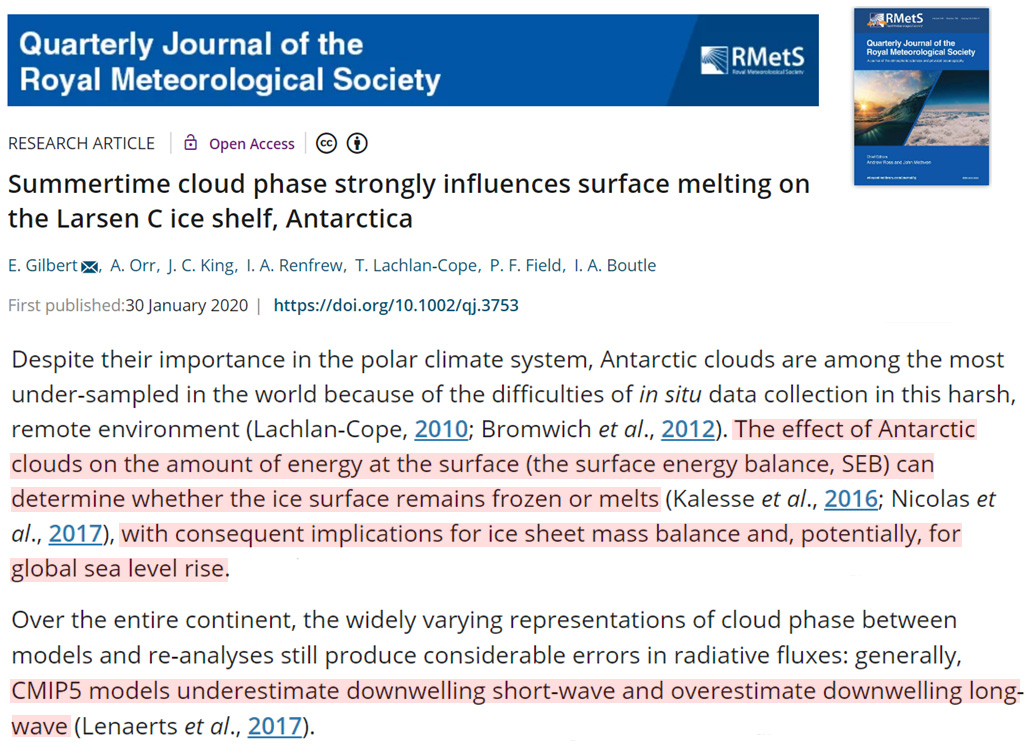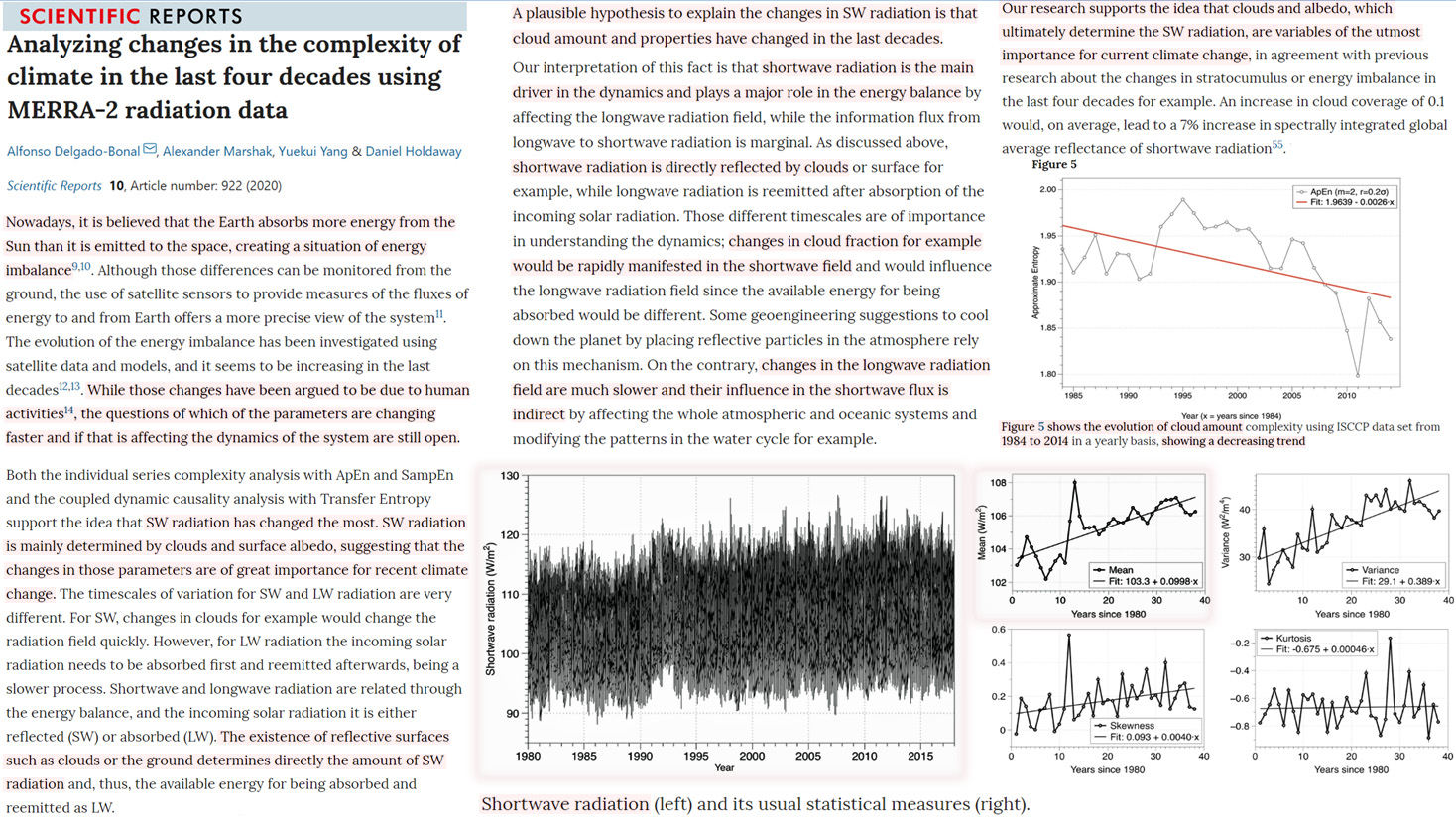By Kenneth Richard on 4. June 2020
Polar ice melt, Earth’s radiation budget, sea surface temperatures, water circulation, and climate variability are all “controlled” or “crucially regulated” by clouds.

1. Gilbert et al., 2020
“Surface melting on Antarctic Peninsula ice shelves can influence ice shelf mass balance, and consequently sea level rise. We show that summertime cloud phase on the Larsen C ice shelf on the Antarctic Peninsula strongly influences the amount of radiation received at the surface and can determine whether or not melting occurs.”
2. Lee et al., 2020
“Clouds are one of the most important factors determining the radiation budget. In other words, all surface solar irradiances (SSI), atmospheric absorptions (AA), and reflection irradiances (RI) at TOA can be different according to the presence of clouds in the atmosphere…. Clouds in all- (or overcast-) sky atmosphere diminish surface solar irradiances (SSI) from 218.1 Wm−2 to 156.9 Wm−2 (or 85.8 Wm−2) and enhance atmospheric absorptions (AA) from 61.5 Wm−2 to 86.3 Wm−2 (or 128.2 Wm−2). Clouds also enhance the reflected irradiances (RI) at the TOA from 65.6 Wm−2 to 102.0 Wm−2 (or 131.2 Wm−2) for all- (or overcast-) skies. As a result, the all- (or overcast-) sky shortwave (SW) cloud forcing (CF) is −61.2 Wm−2 (or −132.3 Wm−2) at the surface, AA is 24.8 Wm−2 (or 66.7 Wm−2) in the atmosphere and RI is 36.4 Wm−2 (or 65.6 Wm−2) at the TOA, respectively.”
3. Li et al., 2020
“Cloud radiative effects (CREs) are known to play a central role in governing the long-term mean distribution of sea-surface temperatures (SSTs). Very recent work suggests that CREs may also play a role in governing the variability of SSTs in the context of the El Niño/Southern Oscillation.”
4. Pan et al., 2020
“Clouds crucially regulate atmospheric energy balance, water circulation, and Earth’s climate system with multiple spatiotemporal scales (Boucher et al. 2013). Fundamental conundrums on clouds, the coupling of clouds with atmospheric circulation, and climate interactions have remained unsolved and have been identified as considerable challenges in climate research (Bony et al. 2015). One of the largest uncertainties amongst these challenges is the vertical property of clouds and their radiative effects (Li et al. 2015). Vertical variation of clouds can affect the vertical distribution of atmospheric radiative heating, surface energy balance, and general circulation by changing the vertical structure of radiative warming and cooling rates (Johansson et al. 2015; Pan et al. 2017). Quantifying the vertical distribution of cloud radiative forcing and their impacts on atmospheric circulation and regional climate has become critical.”
5. Yin and Porporato, 2020
“Toward this goal, here we analyze the radiation at the top of the atmosphere and propose a measure of the DCC [diurnal cloud cycle] radiative effect (DCCRE) as the difference between the total radiative fluxes with the full cloud cycle and its uniformly distributed cloud counterpart. When applied to the frequency of cloud occurrence, DCCRE is linked to the covariance between DCC and cloud radiative effects. Satellite observations show that the daily cloud cycle is strongly linked to pacific decadal oscillation (PDO) and climate hiatus, revealing its potential role in controlling climate variability.”
6. Delgado-Bonal et al, 2020
“Our research supports the idea that clouds and albedo, which ultimately determine the SW radiation, are variables of the utmost importance for current climate change, in agreement with previous research about the changes in stratocumulus or energy imbalance in the last four decades for example. An increase in cloud coverage of 0.1 would, on average, lead to a 7% increase in spectrally integrated global average reflectance of shortwave radiation.”
“When reaching the Earth, part of the incoming solar radiation is reflected off clouds and the surface as shortwave radiation (SW). Changes in cloud distribution or the surface albedo affect this flux and change the energy balance. In the last four decades, changes in cloud distribution in low-level clouds such as subtropical stratocumulus have been of great importance since they have the ability to reflect large amounts of radiation back to space but do not reduce significantly the outgoing terrestrial radiation. … [S]hortwave radiation is the main driver in the dynamics and plays a major role in the energy balance by affecting the longwave radiation field.”
“The existence of reflective surfaces such as clouds or the ground determines directly the amount of SW radiation and, thus, the available energy for being absorbed and reemitted as LW. … A plausible hypothesis to explain the changes in SW radiation is that cloud amount and properties have changed in the last decades.”

Posted in Cloud Climate Influence |







But clouds are regulated by Man Made CO2. That’s what my models say.
(Or they will, if you send me enough money to set up some models.)
I can see many right and true things among these papers but what makes the most clouds?
The beautiful thing about clouds is they are predictably generated by the tropics closely following ENSO activity.
https://i.postimg.cc/xqVd4KXZ/Clouds-OLR-and-MEI.jpg
ASR, absorbed solar radiation warms the ocean depths that ultimately generates evaporation and clouds. An equal amount of ASR can be obtained from either low or high TSI under opposite albedo/cloud states.
Clouds generated by yesterday’s sun modulate today’s sun.
ENSO activity follows the solar cycle, at the onset & after the max.
My whole point being, clouds aren’t some wholly independent variable nor are they controlled by cosmic rays, they are predictably tropical.
And from here a while back…
https://notrickszone.com/2019/08/29/nasa-we-cant-model-clouds-so-climate-models-are-100-times-less-accurate-than-needed-for-projections/
“NASA has conceded that climate models lack the precision required to make climate projections due to the inability to accurately model clouds. ”
We knew that anyway, but it was kind of NASA to confirm this. What they are really saying is that the models suck.
Whoops….
https://wattsupwiththat.com/2020/06/05/cloud-feedback-if-there-is-any-is-negative/
Whoops….
https://notrickszone.com/2019/08/29/nasa-we-cant-model-clouds-so-climate-models-are-100-times-less-accurate-than-needed-for-projections/
It takes clouds to make rain. Raindrops transport coldness from high, cold altitudes to the surface. Could rain be the negative forcing we have been searching for?
[…] In 6 New Studies Scientists Agree Clouds Play A ‘Central Role’ In Regulating The Earth&r…, da NoTricksZone.com […]
http://webarchive.loc.gov/all/20070913051956/http%3A//www.wecnmagazine.com/2007issues/may/may07.html
Reid Bryson commenting on water vapour in 2007:
“Q: Could you rank the things that have the most significant impact and where would you put carbon dioxide on the list?
A: Well let me give you one fact first. In the first 30 feet of the atmosphere, on the average, outward radiation from the Earth, which is what CO2 is supposed to affect, how much [of the reflected energy] is absorbed by water vapor? In the first 30 feet, 80 percent, okay?
Q: Eighty percent of the heat radiated back from the surface is absorbed in the first 30 feet by water vapor…
A: And how much is absorbed by carbon dioxide? Eight hundredths of one percent. One one-thousandth as important as water vapor. You can go outside and spit and have the same effect as doubling carbon dioxide.”
[…] In 6 New Studies Scientists Agree Clouds Play A ‘Central Role’ In Regulating The Earth&#… […]
Hi Kenneth,
Here is an earlier seventh study. (https://principia-scientific.org/record-temperature-result-of-cloud-revised-updated/)
Have a good day, Jerry